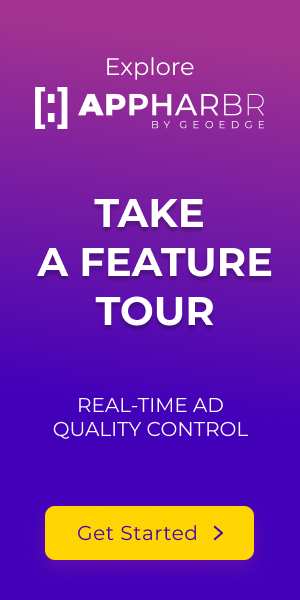Age-Inappropriate Ads Are a Critical Threat to Publishers Today
For publishers operating kids’ apps, ad monetization is a balancing act: drive strong engagement while keeping user experience safe, compliant, and on-brand. Navigating Programmatic monetization and preventing age-inappropriate creatives remain one of the most persistent and complex ad quality challenges.
Most ad quality strategies are static or reactive; most ad monetization teams rely on blocking categories or advertisers after the incident. AppHarbr uses AI and machine learning to proactively block nuanced policy violations that fall through network and mediation filters.
In this post, we’ll dissect exactly how these harmful ads slip through the cracks, outline why conventional approaches aren’t sufficient, and explore the advanced real-time filtering methods necessary for truly robust ad quality control. Discover solutions designed specifically to block age-inappropriate ads reliably and in real time, enabling publishers to protect revenue, preserve brand integrity, and maintain steady protection against inappropriate ad content.
Why Real-Time Ad Quality Matters in Kids’ Apps
Mediation platforms like AppLovin MAX, LevelPlay, and AdMob offer important ad quality safeguards—category exclusions, blocklists, and creative reviews. But these are fundamentally reactive tools, responding to known issues after creatives are live or flagged.
In high-sensitivity environments like kids’ apps, waiting for detection isn’t an option.
That’s where AppHarbr comes in:
- It operates in real time, at the impression level
- Enforces publisher-defined ad quality controls, not just defaults
- Blocks harmful, policy-violating, or off-brand ads before they’re ever seen
- Protect Users from Ad Security Threats
Detect and block malicious code, redirects, and other harmful behaviors in real time.
- Prevent Unsafe or Malicious Advertisers and Practices
Identify and stop ads from bad actors, suspicious brands, and deceptive ad sources.
- Control Unwanted Ad Content
Block ad creatives with inappropriate or sensitive themes, including:
- Adult or sexually suggestive content
- Shocking or graphic imagery
- Politically sensitive material
- Fake download buttons or misleading CTAs
AppHarbr helps publishers stay compliant with platform-specific policies to ensure ad experiences are safe and appropriate for children. Learn more about these guidelines here:
- Google Play Families Policy
Complete Creative-Level Visibility
Every blocked impression is logged and traceable. Get details like:
- Creative ID
- Network/partner
- Geo creative was served by
- Block reason
- Screenshot of creative and landing page
Out of Place and Out of Control: The Growing Problem of Age-Inappropriate Ads in Kids’ Apps
Age-inappropriate ads in kids’ apps aren’t just a UX blemish; they’re an indicator of deeper, systemic fractures in the programmatic ecosystem. Publishers of kid-focused apps and games invest heavily in maintaining a curated, safe experience. Yet, despite strong intentions and tedious QA, inappropriate ad placements persist. These ads range from mildly off-brand content to unsuitable promotions such as gambling, dating, violent imagery, or explicit themes that can repel users and harm the publisher’s reputation. Crucially, these misplaced ads erode user trust, triggering immediate churn and significantly impacting lifetime user value (LTV). The additional layer of risk when it comes to age-inappropriate content exposure to legal and commercial consequences for violation of policies and regulations.


Inside the Programmatic Pipeline: How Inappropriate Ads Sneak into Child-Focused Apps
To effectively combat age-inappropriate ads, it’s necessary to understand precisely how they infiltrate child-focused apps. There are many points along the programmatic advertising pipeline for inappropriate content to slip through unnoticed. Because these creatives are not inherently malicious or broken, this content is likely to go unnoticed and be served to the wrong audience by mistake. Advertisers may intentionally misrepresent ad content to get campaign approval or unintentionally serve an ad that may be appropriate for some audiences to users for whom it’s not appropriate. But the high volume and fast-paced environment have its issues. DSPs simply aren’t agile enough to catch inappropriate content in real-time. Additionally, bad actors frequently employ tactics like post-approval changes to evade detection. Because platforms and networks are not intrinsically built to address these nuanced issues proactively, publishers inevitably expose themselves and their users to high-risk creatives, with potentially devastating consequences for their apps and brands.
Traditional Ad Quality Approaches: Why Manual QA and Mediation Aren’t Enough
In a reactive workflow, publishers find out about issues only after complaints have been made, leading to a negative reputation for your app.
Admon teams are made aware of issues via:
- App Store reviews and complaints
- Social media platforms
- Reddit threads and similar parent forums
Many publishers depend heavily on traditional methods such as manual quality assurance checks and built-in tools provided by their mediation platforms, assuming these measures are sufficient to block age-inappropriate ads. However, these approaches quickly reveal major scalability and operational limitations. Manual QA—even by highly trained teams—relies primarily on visual spot-checks and tedious efforts that cover only a small fraction of potential creatives.
Complex cases where manual QA falls short:
- A visual has no issues, but the text is inappropriate
- In video the inappropriate content can be hidden in a single frame
- The violation is in the landing page not in the creative
Programmatic Risk in Children’s Apps: Consequences Publishers Can’t Afford
The Apple App Store and Google Play Store explicitly prohibit serving inappropriate or age-inappropriate ads in apps designed for children, particularly those categorized under the Kids section. Violations of these guidelines can result in swift and serious penalties, including app rejection during review, temporary delisting, or even permanent removal from the App Store. In a category where compliance is non-negotiable, failing to meet Apple and Android’s expectations can have lasting effects on a publisher’s business.
And as for more immediate consequences, inappropriate ad exposures accelerate user churn, especially among family segments sensitive to harmful or offensive content. Each churned user represents lost opportunities for monetization and reduced user lifetime value—metrics critically important to publishers’ profitability models.
So when inappropriate ads infiltrate apps aimed at young users, publishers are not merely contending with upset parents or temporarily frustrated users. Rather, they’re facing bottom-line business impacts.

As the volume of ads delivered via programmatic increases exponentially, manual review alone can’t keep pace or identify threats at scale. Similarly, mediation-based ad management offers a surface-level form of filtering and blocklisting, largely reactive and based on historical occurrences. This leaves publishers vulnerable during the latency period between identification and action. Publishers frequently find themselves engaged in costly, reactive “whack-a-mole” campaigns, blocking ads only after the damage is done. This approach isn’t just inefficient, it’s ineffective and unsustainable.
Toward Child-Safe Advertising at Scale: Why Real-Time Ad Filtering is Mission-Critical
To effectively address the ongoing threat of age-inappropriate ads at the scale required by major publishers, a shift toward a proactive, real-time ad filtering solution like AppHarbr is essential. Unlike static blocklists or manual controls, real-time screening instantly blocks unsuitable ads pre-impression The design features an automated, real-time blocking solution, outperforming mediation and alleviating manual QA. This instantaneous, automated intervention closes vulnerability gaps inherent in manual and mediation-based methods, significantly reducing the manual workflow for ad ops teams. For publishers, real-time ad safety is mission-critical to capturing monetization opportunities and fostering long-term user trust.
Securing Your Apps, Audience, and Revenue with AppHarbr
Addressing the complex issue of inappropriate ads demands proactive, real-time solutions. AppHarbr empowers publishers to protect revenue, audience safety, and brand equity. Parents talk. So do app reviewers. AppHarbr helps you prevent App Store review bombs, Reddit callouts, and platform escalations that come from harmful ad experiences. Discover how AppHarbr delivers unparalleled ad protection today.




